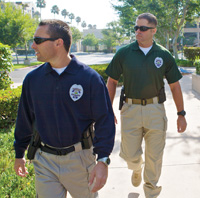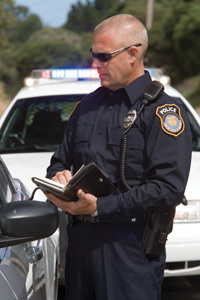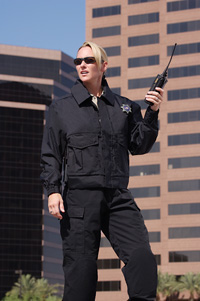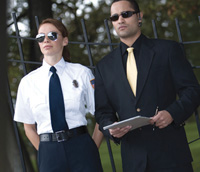|
By Bernadette Doran It’s true, Officer Friendly has been fired. The smiling, approachable policeman in powder blue and navy, an icon of safety, reassurance and trust during America’s more innocent 1950s and ’60s, has gone the way of the Atari and The Ed Sullivan Show. He’s now nothing but a quaint, fond memory. When did he officially get the pink slip? Sept. 11, 2001. Once America recovered from the reeling shock of the attack on the Twin Towers and an unprecedented vulnerability, a heightened need for protection emerged, and law enforcement uniforms began evolving in response. So goodbye, Officer Friendly. Hello, Men (and women) in Black. “The military look is in because of what’s been going on the last decade, especially 9/11 and continuing threats of terrorism,” says Steve Leventhal of Leventhal Ltd. “The purpose of the military uniform on a police officer is to alert people that you are a security entity. You’re somebody who’s carrying a gun. And dark colors are meant to be intimidating.” In fact, says Leventhal, the latest thing taking hold in law enforcement is battle dress uniform (BDU) styling. “Pants have side pockets where you can carry a weapon, a log book, a radio. That has become the current look,” he says, adding that New York City police now have BDU pants as their official regulation trouser. “No more straight dress pant. Now they’ve got the SWAT team look.” The move to paramilitary dress has raised questions and created challenges. How do you create garments that keep their commanding look but offer comfort and mobility? What are the psychological implications of this shift in color and style, and does it help or hinder the police? In the United States, the color blue is associated with feelings of comfort and security we are a “true blue” country, according to Richard R. Johnson of the University of Cincinnati in the article “The Psychological Influence of the Police Uniform.” Black is most often associated with power and strength. But Americans as well as people in Europe, Western Asia, Central Africa and the Middle East also consistently perceive dark colors as evil. Think Darth Vader, wicked witches and stepmothers in Walt Disney movies, and the bad guy in every classic Western you’ve ever seen. So while a black police uniform sends a clear message of authority and intimidation, that message could encourage a more hostile response and endanger the officer. “On psychological inventories, dark colors elicit emotions of anger, hostility, dominance and aggression,” writes Johnson. “These negative feelings may encourage some citizens to consider violent action when confronted by the police because the citizen perceives the officer as aggressive.” In his article “Citizen Perceptions of Police Uniforms,” author Detective Joseph Petrelli points to other research conducted by Johnson. Johnson set out to determine what police uniform color combinations produced the most positive and negative impressions on a test group of 120,000 American citizens. Participants were shown 8-by-10 photos of the following police uniform color schemes: Uniform one was a light blue shirt and navy pants typically worn by police in Chicago, Philadelphia, Houston and Kansas City. Uniform two was a white shirt and black pants typically worn by police in Cincinnati and Columbus, Ohio. Uniform three was the most common police uniform in the United States, a black shirt and black pants typically worn by police in New York City, Indianapolis, Miami and Atlanta. Uniform four was a khaki shirt and khaki pants typically worn by police in Las Vegas and Wichita, Kan. Participants were asked to grade the uniforms on a scale of one to five in areas of good/bad, nice/mean, warm/cold, gentle/forceful, friendly/unfriendly, passive/aggressive and honest/corrupt. “The combination of the light blue shirt over the navy blue pants was viewed most favorably in all seven categories. This uniform was judged as the least mean, the least forceful, the least cold and the least aggressive,” writes Petrelli. “The black shirt/black pants combination was viewed least favorably in six of the seven categories. This uniform was perceived to be cold, corrupt, forceful, unfriendly and aggressive.” So ultimately the all-black is probably good news if the person encountering the uniform is a terrorist, but not so much if it’s a U.S. citizen, argues Petrelli. “If the dark uniform subconsciously creates negative images in citizens, police are starting out from a position of disadvantage in any street encounter. It will be more difficult to gain citizen trust and cooperation,” says Petrelli. “If the officer is dealing with an emotionally disturbed person or highly agitated subject, the color of his or her uniform may exacerbate aggressive feelings.” Color preference for law enforcement uniforms may depend on a city’s trauma history. Without question, the horrifying experience of 9/11 would make New York City residents want their black-clad police to look as menacing as possible, to ward off even the most remote chance of terrorism. And in London, England long a site of terrorist activity police forces have adopted a uniform of black roll-neck tops and combat pants. But other cities that haven’t suffered such horrific blows may think differently. “A lot of police departments are choosing olive drab over black because it doesn’t intimidate the public. Police don’t want the public to have the opinion that they’re rough and gruff and trying to push you around,” says Darryl Jacks of Atlanco, suppliers of apparel and equipment under the Atlanco and Tru-Spec brands. Jacks is calling olive drab “the new black” because of all the orders he’s now getting for it. “Also, black gives the appearance of being hard to see in the dark, but that’s not true, it actually stands out,” adds Jacks. “Olive drab blends in better and it gives more of a comfortable look.” Whatever color he wears, the police officer in these changing times is required to be more of an action hero than ever before, and the uniform must allow mobility to match. “It’s dangerous to give an officer something that looks professional but is not functional. You’re putting his life in danger,” says Francisco Morales, president of 5.11 Tactical. “If somebody needs to be agile, to run, to carry equipment, to chase people, they need to be safe at what they do. We need to listen to them and find out what they need. And then we have to come up with innovative ways to achieve the performance without sacrificing the professional appearance, because both things are important.” Morales continues, “We do a lot of work making a garment more comfortable, and what we mean by comfortable is increasing the range of motion. Some say a uniform needs to be completely utilitarian, but that means it may not be the right image to the public. Others say let’s just take care of the image, but that may make a uniform unsafe. The officers need to be able to move around and protect.” There’s also morale. “Imagine going to work in something that was too tight, or you felt that you couldn’t move. How do you think you’ll perform on your job?” adds Morales. Listening is where law enforcement design begins, according to Steve Gilkerson, vice-president of Perfection Uniform Co. “We start by working with police officers themselves,” he says. “We spend the majority of our marketing funds on wear tests and meeting with officers one-on-one in uniform committees.” Turning the officers’ specific requests into uniforms that meet those needs has paid off for Perfection, which has won the UNIVATOR Award three years running and was honored this year by Apparel Magazine as being one of the 50 most innovative apparel companies. “We’re really proud of that,” says Gilkerson, “because we’re the only uniform company included on that list, which also included Abercrombie and Fitch, Nike and folks like that.” Perfection is in fitting company with Nike because of a breakthrough in how to think about police officers in the first place. “When you listen to the officers, it is all about comfort. This is both men and women, they’re wearing more and more weight everything on their duty belt plus tasers. It’s a tremendous strain on their back and very cumbersome,” says Gilkerson. “We decided to treat them as athletes people who have to move and jump and run. So why not develop a product that’s ergonomically friendly for athletes?” That’s how Perfection came up with its Ergonomic Garment Construction (EGC) system with many innovative features, including a lightweight Snugtex waistband. “Trousers for officers have to be very high rise because they have to carry a lot of equipment weight above the pelvis, to prevent back injuries. Women especially would prefer to have a lower rise pant, but that defeats the purpose of what they’re trying to do. So if the product has to be above the pelvis, we wanted to make it as comfortable as it can be,” says Gilkerson. “We heard from the committee feedback that uniform waistbands weren’t very comfortable,” he says. “These people have to move, so we thought why not put movement into that waistband.” That’s not the only place officers who often need to kneel, climb or crawl wanted movement, Gilkerson says. “One of the things we noticed from skiwear and outdoor wear was a very old feature of uniforms that had been lost over the years gussets. By using a hidden gusset in the crotch, it’s a tailored pair of pants but you can do a split in those pants.” That gusset gives them not only comfort but also life-saving mobility. “When they’re running and doing all the things they need to do, we don’t want officers to be bound, because a split second makes a difference in the importance and safety of what they’re doing,” adds Gilkerson. “It also virtually eliminates the old specter of crotch blowout, which is a real problem among police officers.” As a result, says Gilkerson, the EGC system has the most mobility in a Class A or B pant. “It’s got the mobility of a battle dress uniform but the image of a policeman. Our intention is to have a tailored uniform appearance but have the performance of a utilitarian garment.” At Atlanco, which specializes in more casual options for officers, the waistband and the rise create a unique product. “Our 24/7 Pant has a comfort waistband that gives you a four-inch expansion. If you have to do maneuvers or bend down, it gives and is very comfortable,” says Jacks. “It’s also engineered to have a dimensional fit, meaning the rise changes as the size changes. Most companies have a waist and a length and that’s it. Our rise changes with the length of the pant to give a more comfortable fit. So the waistband and the engineered dimensional fit set the 24/7 Pant apart from the others.” In designing the 5.11 Tactical apparel, says Morales, inspiration came from protective athletic clothing. “When we developed our under-gear line, which you never see because it goes under the garments, we included compression garments. It’s like an extra layer of tissue that holds your body in and prevents pulling a muscle. An athlete wears these types of garments for three or four hours, but officers wear them for eight hours or more,” he says. The needs of the police officer dictated more specific design applications, says Morales. “We made sure the garments have different compressions in different areas. For the lower back, where officers carry all their equipment, they need back support so there’s more compression there. Under the arms, there’s the least compression and a lot of breathability. So you can bring innovation into what you do, and clothing becomes a necessary part of law enforcement equipment versus something that works against them.” The same thinking has made 5.11 Tactical pants a popular item. Morales says, “We get a lot of compliments across all of our pants. Pants are a little difficult to fit everyone, but our pants, with an expandable waist, gusset at the crotch, articulation at the knee and internal knee protection that can be easily removed, all go into a very comfortable pant to wear.” Shirts have different challenges, and a medieval design detail is making a big comeback in the 21st century for police and pro football uniforms alike. The same detail Perfection Uniform Co. added to its pants is also showing up in its shirts. According to Gilkerson, “Gussets were used in the Middle Ages in shirts for men who carried swords. They give you full-arm extension with ease. So we built in a gusset that’s hidden beneath the sleeve of our shirt and runs the length of the body.” What that does, says Gilkerson, is eliminate the seam. “If you’re reaching forward, what limits your reach is the seam. If you look at football uniforms, they’ve gone to gussets too, to allow players to have the most mobility possible while still maintaining that tailored look.” Similarly, the 5.11 Tactical shirt has a bi-swing pleat in the body to accomplish the same goal. Morales says, “When you extend your arm, you’re pulling a pleat on the back, but when you drop your arm, the pleat hides again. It’s one of the features that allows you to have range of motion, to jump, and that’s what the guys in the field have asked us to do.” Another challenge 5.11 took on was to create a shirt that would carry, but still hide, police gear. “We have a casual shirt with hidden pockets. When you look at it you can’t see any of the pockets, which are hidden on the inside,” says Morales. “It took us two years’ worth of work to figure out how to put pockets in so that you can’t see them, and when you put something in the pockets, you can’t see that either. So we have developed a lot of technologies around that to not sacrifice appearance yet give the shirt its ideal functionality.” Innovative technologies for new law enforcement uniforms include nanotechnology fabrics. Leventhal says, “Wickability, breathability, stretch that’s where the concentration is. New technologies are creating new possibilities for adding stretch in a mechanical way, because Lycra is expensive and budgets are important.” The end result of all these innovations is to have alternatives that look professional but have much more functionality. “When we talk to a new client, they may be very into professional appearance, but when they see the full line, they realize they can accomplish both. They don’t have to sacrifice functionality for appearance,” says Morales. “Plus it does wonderful things for morale. So this uniform is an effective tool not only to make them more efficient but also more confident.”
|
|
| Above story first appeared in MADE TO MEASURE Magazine, Spring & Summer 2009 issue. All rights reserved. Photos appear by special permission. | |
| Halper Publishing Company 633 Skokie Blvd, #490 Northbrook, IL 60062 (877) 415-3300 Fax (224) 406-8850 [email protected] |
|














